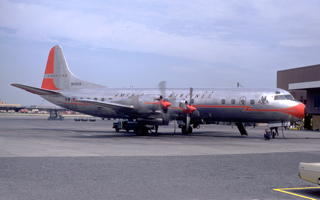Background Information.
The L-188 Electra is an American turboprop airliner built by the Lockheed Corporation. First flown in 1957, it was the first large turboprop airliner built in the United States. Initial sales were good, but after two fatal crashes that led to expensive modifications to fix a design defect, no more were ordered. With its unique high power-to-weight ratio, huge propellers and very short wings, which resulted in the majority of the wingspan being enveloped in propwash, large Fowler flaps which significantly increased the effective wing area when extended, and four-engined design, the airplane had airfield performance capabilities unmatched by many jet transport aircraft even today - particularly on short runways.
Jet airliners soon supplanted turboprop airliners for many purposes, and many Electras were modified as freighters. Some Electras are still being used in various roles into the 21st century.
In 1951 Lockheed was approached by Capital Airlines to develop a new turboprop airliner which was designated the YC-130. However there was no interest from any other carriers, so the design was dropped. Subsequently, Capital Airlines went on to order 60 British Vickers Viscount aircraft. In 1954, as a result of American Airlines’ interest in developing a twin engine aircraft, the idea resurfaced and the company offered a twin-engine design now designated the CL-303. This newer design was a high-wing type and would allow for 60 to 70 passengers. This design was also shelved for lack of interest.
The following year, American Airlines revised its requirement to a four-engine design for 75 passengers with 2,000 miles (3,200 km) range. Lockheed proposed a new design, the CL-310 with a low wing and four Rolls-Royce Darts or Napier Elands. The CL-310 design met the American Airlines requirements, but failed to meet those of another interested airline, Eastern Air Lines. Its requirements were for a longer range with a minimum cruising speed of 350 miles per hour (560 km/h), and increased seating capacity for 85-to-90-passenger level.
Lockheed redesigned the CL-310 to use the Allison 501-D13 turboprop engine, a civilian version of the T56 developed for the Lockheed C-130 Hercules military transport. The airframe was stretched to allow for more seats and handle the increased performance. The revised design was launched as the Model 188 with an order for 35 by American Airlines on June 08, 1955. This was followed by Eastern Air Lines with an order for 40 on September 27, 1955. The first aircraft took 26 months to complete and by that time Lockheed had orders for 129.
The prototype, a Model 188A, first flew on December 06, 1957, two months ahead of schedule. Lockheed was awarded a type certification by the Civil Aeronautics Administration (CAA) on 22 August 22, 1958. The first delivery, to Eastern Air Lines, was on October 08, 1958, but it did not enter service until January 12, 1959.
In 1957 the United States Navy issued a requirement for an advanced maritime patrol aircraft. Lockheed proposed a development of the Electra that was later placed into production as the P-3 Orion, which saw much greater success, the Orion has been in continual front-line service for more than 50 years.
